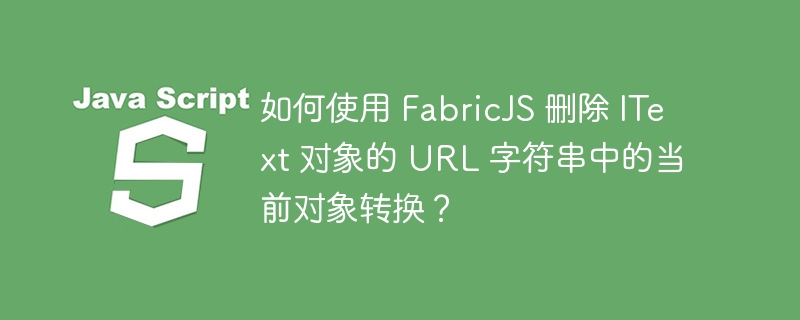

In this tutorial, we will learn how to remove the current object transformation (scale, angle, flip, skew) from the URL string of an IText object using FabricJS. The IText class was introduced in FabricJS version 1.4, which extends Fabric.Text and is used to create IText instances. IText instances give us the freedom to select, cut, paste or add new text without additional configuration. There are also various supported key combinations and mouse/touch combinations to make text interactive that are not available in Text.
However, IText-based Textbox allows us to resize the text rectangle and wrap it automatically. This is not the case for IText, as the height does not adjust based on line breaks. We can manipulate IText objects by using various properties. Similarly, we can use the withoutTransform property to remove the transform of the current object in the URL string of the IText object.
toDataURL({ withoutTransform: Boolean }: Object): String
Options (optional) - This parameter is an object that provides additional customization for the URL representation of the IText object. Height, quality, format, and many other properties can be changed using this parameter, where withoutTransform is a property.
withoutTransform - This property accepts a Boolean value which allows us to get rid of the current object transformation. By passing it a true value, there will be no scale, angle, flip, or tilt in the final output image.
Use the withoutTransform attribute and pass it a false value
Let's look at a code example to see the output image when passing a false value to the withoutTransform property. Once we open the console from the development tools, we can see the URL representation of the IText object. We can copy the URL and paste it into the address bar of a new tab to see the final output. In this example, we pass the IText object a scaleY property that specifies the vertical scale factor. So our output will be scaled vertically. However, since we also passed a false value to the withoutTransform property, our final output image will still contain the scaleY property.
<!DOCTYPE html>
<html>
<head>
<!-- Adding the Fabric JS Library-->
<script src="https://cdnjs.cloudflare.com/ajax/libs/fabric.js/510/fabric.min.js"></script>
</head>
<body>
<h2>Using the withoutTransform property and passing it a false value</h2>
<p>You can open console from dev tools and see the output URL. You can copy that and paste it in the address bar of a new tab to see that the final image contains vertical scaling </p>
<canvas id="canvas"></canvas>
<script>
// Initiate a canvas instance
var canvas = new fabric.Canvas("canvas");
canvas.setWidth(document.body.scrollWidth);
canvas.setHeight(250);
// Initiate a shadow object
var shadow = new fabric.Shadow({
blur: 25,
color: "grey",
offsetX: 12,
offsetY: 15,
});
// Initiate an itext object
var itext = new fabric.IText(
"Add sample text here.Lorem ipsum dolor sit amet consectetur adipiscing.",{
width: 300,
left: 60,
top: 70,
fill: "#c70039",
backgroundColor: "#c1dfed",
stroke: "#c70039",
originX: "center",
shadow: shadow,
scaleY: 2,
}
);
// Add it to the canvas
canvas.add(itext);
// Using the toDataURL method
console.log(
itext.toDataURL({ withoutTransform: false })
);
</script>
</body>
</html>
Use the withoutTransform attribute and pass it a true value
Let's look at a code example to see what the final output image of an IText object looks like when using the withoutTransform property and passing a true value to it. In this case, our final output image will not contain any object transformations.
<!DOCTYPE html>
<html>
<head>
<!-- Adding the Fabric JS Library-->
<script src="https://cdnjs.cloudflare.com/ajax/libs/fabric.js/510/fabric.min.js"></script>
</head>
<body>
<h2>Using the withoutTransform property and passing it a true value</h2>
<p>You can open console from dev tools and see the output URL. You can copy that and paste it in the address bar of a new tab to see that the final image does not contain vertical scaling </p>
<canvas id="canvas"></canvas>
<script>
// Initiate a canvas instance
var canvas = new fabric.Canvas("canvas");
canvas.setWidth(document.body.scrollWidth);
canvas.setHeight(250);
// Initiate a shadow object
var shadow = new fabric.Shadow({
blur: 25,
color: "grey",
offsetX: 12,
offsetY: 15,
});
// Initiate an itext object
var itext = new fabric.IText(
"Add sample text here.Lorem ipsum dolor sit amet consectetur adipiscing.",{
width: 300,
left: 60,
top: 70,
fill: "#c70039",
backgroundColor: "#c1dfed",
stroke: "#c70039",
originX: "center",
shadow: shadow,
scaleY: 2,
}
);
// Add it to the canvas
canvas.add(itext);
// Using the toDataURL method with withoutTransform
console.log(
itext.toDataURL({ withoutTransform: true })
);
</script>
</body>
</html>
The above is the detailed content of How to remove current object cast from URL string of IText object using FabricJS?. For more information, please follow other related articles on the PHP Chinese website!
 Main purpose of file system
Main purpose of file system
 How to solve garbled tomcat logs
How to solve garbled tomcat logs
 How to restore mysql database
How to restore mysql database
 How to use the decode function
How to use the decode function
 Is there a big difference between c language and Python?
Is there a big difference between c language and Python?
 index.html function
index.html function
 Win10 does not support the disk layout solution of Uefi firmware
Win10 does not support the disk layout solution of Uefi firmware
 How to open state file
How to open state file
 No service on mobile data
No service on mobile data




